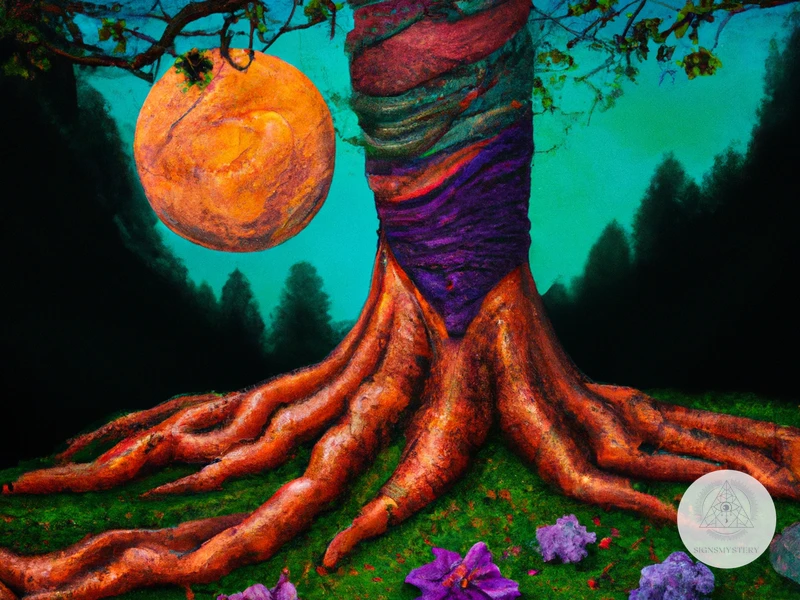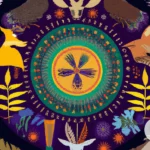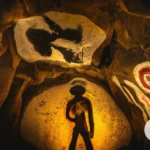The world of shamanism that stretches across cultures is often shrouded in mystery and myths that continue to fascinate people until modern days. One such captivating myth is the World Tree, a symbol that appears in many shamanic traditions around the world. Though its forms and meanings may differ among cultures, the World Tree represents a common theme of the axis mundi, a bridge between the physical and the spiritual realm. In this article, we will explore the origins and symbolism of the World Tree in shamanic beliefs and how it has become a central figure in human consciousness.
What is Shamanism?

Shamanism is a spiritual practice that has existed for centuries and has been practiced by different cultures worldwide. According to its beliefs, shamans have the power to communicate with the spirit world and can use this ability to heal others. This practice is based on the belief that everything has a spiritual essence and all things are interconnected. In shamanism, the emphasis is placed on personal spiritual experience, including visions and dreams. Shamans use various techniques such as chanting, dance, and meditation to reach an altered state of consciousness, where they can gain access to the spirit realm. Animals, plants, and celestial bodies are highly revered in shamanism, and are believed to contain spiritual power that can be harnessed for healing. The connection between shamanism and nature is strong, and many traditional shamanic cultures see themselves as caretakers of the natural world.
Origins and Key Beliefs
Shamanism is considered one of the oldest spiritual practices, with its origins dating back more than 30,000 years. Shamanism is rooted in animism, the belief that all living things possess a spirit or soul. According to shamanic beliefs, the natural world is not a collection of inanimate objects, it is instead composed of living, intelligent beings. Shamans are believed to have the ability to communicate with these beings, including animal spirits and plant powers, and the spirits of the dead.
Shamanism also emphasizes the importance of living in harmony with the Earth and its cycles. The Moon is particularly significant in shamanic belief systems, with the cycles of the Moon being seen as a metaphor for death and rebirth. Many shamans also believe in a mythological connection between shamanism and the Moon.
The role of the shaman is to bridge the gap between the physical and spiritual realms. Shamans act as healers, diviners, and mediators between individuals and the spirit world. They are also believed to be able to enter into trances and communicate with spirits to gain insight and wisdom.
In shamanic cultures, illness is seen as a result of disharmony between the individual, their community, and the natural world. Shamans seek to restore balance and harmony through spiritual practices such as ritual, plant medicine, and transformative experiences.
Shamanism is a complex belief system with several key tenets, including animism, communication with spirits, living in harmony with the natural world, and the role of the shaman as healer and mediator between the physical and spiritual realms. Its origins and beliefs have influenced many spiritual practices we see today, such as ancestor shamanism mythology.
Shamanic Practices Around the World
Shamanic practices have been carried out for thousands of years in various parts of the world, including in North and South America, Asia, Europe, and Africa. Despite the differences in geography, culture, and beliefs, shamanic practices share similar basic principles and techniques.
Here are some examples of shamanic practices from around the world:
- North and South America: Shamanism has been practiced by Native American communities for millennia. The shaman or medicine man/woman communicates with spirits, performs healings, and leads ceremonies. In South America, Ayahuasca is a traditional shamanic medicine used for healing and spiritual growth.
- Asia: Shamanistic practices vary throughout Asia, but they are still widely practiced today. In Mongolia, shamans communicate with spirits through drumming and rituals. In Korea, the Muism tradition involves communicating with spirits and performing exorcisms. In Siberia, shamanism includes healing ceremonies and rituals for hunting success.
- Europe: Shamanic practices were common throughout Europe before the introduction of Christianity. Shamans would communicate with spirits of animals, nature, and ancestors. In Scandinavia, the tradition was particularly strong, with the use of runes and communicating with the god Odin.
- Africa: African shamanism is diverse due to the continent’s vast size and cultural diversity. In West Africa, the practice of Vodun involves communicating with spirits and performing healing ceremonies. The San Bushmen in southern Africa practice trance dancing where the shaman enters a trance to communicate with the spirit world and receive guidance.
Shamanic practices around the world show a deep connection between humans and the spiritual world. The techniques used by shamans vary, but they all involve some form of connecting with spirits or ancestors for healing, guidance, and spiritual growth.
The Myth of the World Tree
The myth of the world tree is a prevalent belief across multiple cultures and religions, often referred to as the cosmic tree, tree of life, or axis mundi. Variations of the myth include a tree that connects the underworld, earthly realm, and heaven, and sometimes even serves as a divine ladder for souls to ascend to the afterlife. Norse mythology features Yggdrasil, while Hinduism has the Ashvattha tree, and Buddhism has the Bodhi tree. In Siberian shamanism, the world tree is often depicted as the Siberian pine, which is believed to be the center of the world. The symbolic meaning of the world tree is often associated with the cycle of life and death, renewal and rebirth, and the interconnectedness of all living beings.
Origins and Variations
The myth of the World Tree is one of the most widespread and ancient shamanic beliefs. It can be found in the traditions of many cultures around the world, from the ancient Norse myths of Yggdrasil to the shamanic beliefs of the Siberian tribes. The origins of the myth are still shrouded in mystery, but many scholars believe that it may have arisen independently in different cultures as a result of similar experiences and beliefs.
One of the earliest known examples of the World Tree myth comes from the ancient Sumerian civilization, where it was known as the “Cosmic Tree” or the “Tree of Life”. According to Sumerian mythology, the tree connected the world of the gods with the world of humans, and was guarded by a serpent. Similarly, in Egyptian mythology, the goddess Isis was often depicted standing upon a tree, symbolizing the connection between heaven and earth.
In Norse mythology, the World Tree was known as Yggdrasil, and was believed to be the center of the universe, connecting the nine worlds. Yggdrasil was an enormous ash tree, whose roots and branches extended throughout the cosmos, and was guarded by a dragon and an eagle.
The Native American tribes also had their own variations of the World Tree myth. In the Lakota tradition, the World Tree was known as the “Inyan Kara”, or the “Stone Tree”. This tree was believed to have grown from a stone that fell from the sky, and connected the physical world with the spiritual realm.
Despite the variations in the myth, the World Tree has always been associated with the idea of a sacred center, a point of connection between the physical world and the spiritual realm. It is often seen as a symbol of the shamanic journey, representing the path that the shaman must take to travel between the different worlds and communicate with spirits.
The myth of the World Tree is a powerful symbol that has endured throughout history and across cultures. Its significance in shamanism cannot be overstated, as it represents the very essence of the shamanic journey and the connection between the physical and spiritual realms.
Symbolic Meaning
The World Tree in shamanism has numerous symbolic meanings that vary from culture to culture. However, there are some broader themes that are commonly associated with this concept. One of the most significant themes is the idea of the tree as a bridge between worlds. In many shamanic traditions, the World Tree is seen as a connection between the heavens, the earth, and the underworld. This is why it is often referred to as the “axis mundi,” or the center of the world.
Another common symbolic meaning of the World Tree is growth and renewal. The tree is seen as a representation of the cycle of life, death, and rebirth. The roots of the tree reach deep into the earth, symbolizing the roots of life and the foundation upon which everything is built. The branches, on the other hand, reach up towards the heavens, symbolizing the potential for growth and transcendence.
The World Tree is also associated with spiritual and psychological development. In some cultures, the tree represents the stages of spiritual growth – from a seedling to a fully grown, mature tree. This journey of growth and transformation is reflected in the shamanic initiation process, where the shaman undergoes a series of trials and tribulations in order to gain wisdom and spiritual power.
The World Tree is also a symbol of balance and harmony. The tree’s roots and branches represent the masculine and feminine aspects of life, the yin and yang, and the balance between them. This balance is reflected in the shamanic worldview, which emphasizes the interconnectedness of all things and seeks to maintain harmony within the natural world.
Finally, the World Tree is a symbol of the shamanic journey itself. The tree provides a pathway for the shaman to journey between worlds and access the hidden realms of the universe. This concept is integral to shamanic practice, where the shaman must be able to navigate both the physical and spiritual realms in order to access the healing power of the universe.
The symbolic meaning of the World Tree in shamanism is
Subscribe to Our Newsletter
Sign up to receive the latest news and updates.
The Axis Mundi
The Axis Mundi is a concept that has been present in various cultures throughout history. It refers to the center of the world or the connection between different realms. The term “axis mundi” comes from Latin, and it literally means “center of the world.” In many cultures, the axis mundi is represented by a tree, mountain, or pole. This symbol represents the idea of a link between heaven and earth. Additionally, the axis mundi is seen as a sacred point that allows for communication with other worlds. It is a place where the divine and earthly realms meet, and where one can connect with the spiritual world. The concept of the axis mundi has been used in shamanic practices, religion, art, and mythology, and continues to inspire contemplation and reflection to this day.
Etymology and Historical Context
The term “Axis Mundi” comes from the Latin language, which means “center of the world.” In ancient cultures, a central axis was believed to be the point of connection between the earthly and spiritual realms. Many spiritual beliefs recognize this concept, sharing a similar meaning in their respective mythologies.
Historically, this concept originated from the belief system of ancient civilizations like Egypt, Greece, and Mesopotamia. The idea of the Axis Mundi was widespread across different cultures and religions, and its importance was reflected in various mythologies, rituals, and symbols.
In ancient Egyptian mythology, the “Djed pillar” represented the axis of the world, which was believed to hold up the sky. The Greeks believed in the story of Atlas, who bore the celestial sphere on his shoulders, connecting heaven and earth. Similarly, in Hindu mythology, Mount Meru is regarded as the center of the universe, connecting different worlds.
The concept of Axis Mundi also found its way into many indigenous cultures, including shamanism. Shamans believed that the World Tree acted as the Axis Mundi, connecting the three worlds – the upper world, middle world, and lower world. The World Tree was believed to be a conduit for communication between different planes of existence.
The notion of Axis Mundi has a long and rich history, with its roots in various cultures and civilizations. The concept of a central axis that connects different worlds has been represented through many symbols, myths, and rituals. Shamans believed in the concept of the World Tree as a central axis of the universe, through which spiritual communication could be achieved.
World Tree and Other Axis Mundi across Cultures
Throughout history, many cultures have had their own version of the World Tree, which is also known as the Axis Mundi. In Norse mythology, Yggdrasil was a huge ash tree that connected the nine worlds. In Hinduism, the sacred banyan tree was believed to represent the god Vishnu. The ancient Greeks had the world axis in the form of the Omphalos stone at Delphi. These different representations of the Axis Mundi demonstrate the universal human need for a central and symbolic connection between heaven and earth.
A common theme among the Axis Mundi across cultures is the idea of a connection between the three realms – heaven, earth, and the underworld. The World Tree serves as a link between these realms, providing access and communication between them.
In Native American cultures, the World Tree is often thought to be a communication channel with the supernatural world, allowing individuals to connect with spirits. In ancient Egyptian culture, the Djed pillar represented the backbone of the god Osiris and was seen as the axis around which the heavens revolved.
The tree has always been a powerful symbol in many cultures, providing shelter, food, and medicine. The idea of the Axis Mundi, therefore, is closely tied to the fundamental human need for survival. The World Tree serves as a source of spiritual and physical nourishment, creating a connection between the material and spiritual realms.
The Axis Mundi and the World Tree have been important symbols throughout history, representing a connection between the physical and spiritual realms. The representation varies according to cultural beliefs and practices, but the underlying concept remains the same – a central symbol that connects the three realms.
Conclusion
In conclusion, the myth of the world tree in shamanism is a rich and complex belief system that has been passed down through generations of indigenous cultures worldwide. The world tree or axis mundi is the center of the shamanic universe, connecting the heavens, earth, and underworld.
The symbolic meaning of the world tree varies from culture to culture but frequently represents growth, balance, and interconnectedness. The idea of using the tree as a symbol of spiritual growth and enlightenment is also present in several religions such as Christianity, Hinduism, and Buddhism.
Despite the variations in the myth and its symbolic interpretations, the world tree remains an essential cornerstone of shamanic beliefs, representing the connection between the physical and spiritual realms.
Moreover, as understanding and appreciation of indigenous cultures continue to grow, it is essential to acknowledge the importance of the mythology and symbolism surrounding the world tree in shamanism.
Overall, the significance of the world tree in shamanism illustrates the diversity, depth, and beauty of the world’s cultures. It is an ever-expanding subject that deserves more attention, research, and respect.
Frequently Asked Questions
What is the significance of the World Tree in shamanism?
The World Tree is a symbolic representation of the connection between the physical and spiritual realms in shamanism. It also serves as a central axis or point of reference during shamanic journeys.
What cultures believe in the World Tree?
The World Tree is a common belief in many indigenous cultures, including the Norse, Anglo-Saxon, Celtic, and Native American cultures, among others. It is also present in the mythology and folklore of several other cultures around the world.
What is the Axis Mundi?
The Axis Mundi is a universal symbol representing the center of the world or the point of connection between heaven and earth. In shamanism, it is often represented by the World Tree.
What is the historical context of the Axis Mundi?
The concept of the Axis Mundi dates back to ancient times and has been present in many cultures throughout history. It is believed to have originated as a way to symbolize the connection between different realms and the transcendence of physical boundaries.
What is the difference between the World Tree and the Tree of Life?
The World Tree is a universal symbol representing the connection between the physical and spiritual worlds, while the Tree of Life is a specific symbol representing the interconnectedness of all life on earth.
What is the symbolic meaning of the World Tree?
The World Tree is a symbol of growth, stability, and the interconnectedness of all things. It also represents the spiritual journey and the connection between the physical and spiritual worlds.
How is the World Tree depicted in different cultures?
The World Tree is depicted in different ways across cultures, but it often features prominent roots and branches stretching out to the heavens. It may also be decorated with symbols and ornaments that have cultural or spiritual significance.
What is the significance of shamanic journeys?
Shamanic journeys are a way for individuals to connect with the spiritual realm and receive guidance or healing. They are often facilitated by a shaman or other spiritual guide and involve entering a trance-like state through rituals or other techniques.
What is the role of the shaman in shamanism?
The shaman is a spiritual leader who acts as a guide between the physical and spiritual realms. They are responsible for facilitating shamanic journeys and helping individuals connect with the spiritual world to receive guidance or healing.
What are some common shamanic practices?
Common shamanic practices include rituals such as smudging or drumming, the use of psychoactive substances, and shamanic journeys. These practices are often used to connect with the spiritual realm and achieve spiritual growth or healing.










